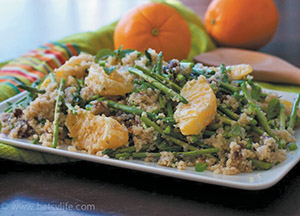
Clean eating is a rather simple food concept. It is basically the path that your food has traveled from its origin to your plate and finally your mouth and body. At its simplest, clean eating is about eating whole foods, or real foods. Foods that are un- or minimally processed, refined and handled, making them as close to their natural form as possible.
Following a clean eating plan is much easier than you might think. It doesn’t require a lot of extra time or money to follow. The basic tips listed below will give you an excellent start to eating clean:
Avoid most packaged and processed foods.
The first step in clean eating is when you are shopping: read labels to avoid added sugars, salts and fats. While bagged, boxed or canned foods can be a convenience—such as canned vegetables, make the habit of looking for added sugars, salt and fats. You can always “correct” the flavors by seasoning your foods with your own additions.
Choose real foods.
Look for foods that you can recognize in their whole, natural state. Choose seasonal fruits and vegetables that are grown locally. Your supermarket will list where produce is grown. The shorter the distance the food has traveled the better.
Cut back on added sugars.
Most humans gravitate to sweet treats. Fruit is nature’s candy. Fresh or dried fruit make an excellent nutritious snack. Fruit is easy to transport, economical and a treat for your taste buds. There is a tremendous range of sweetness in fruits. Slightly under-ripe fruit is on the lower end of the sweetness scale, while super-ripe and dried fruits concentrate and boost the sweetness levels. Watch packaging for descriptions like “made from real fruit”; usually it will contain only 10-15 percent real fruit.
Avoid trans-fats/ Limit saturated fats.
Use heart-healthy plant-based oils like nut oils, pure extra-virgin olive oil or avocado. Swap out processed and packaged foods; they are the main sources of trans fats.
Cook and eat at home.
When you cook at home you know the ingredients and seasonings in every dish. No guesswork or taste-testing for hidden fats, salt and sugar. You can personalize your eating with spices and herbs instead of salt, smaller amounts of healthy fats and a lot less sugar.
Stay hydrated.
Our bodies require a large amount of water for optimal performance. Fruits and vegetables are mostly water and contribute a large portion of daily fluid needs. Shoot for at least 6-8 glasses of water daily (which also includes non-caffeinated drinks, like herbal teas and coffee and seltzer). Spruce up your water with a slice of fruit: lemon, lime, oranges, slices of strawberry or even cucumber and mint. Limit caffeine intake. A little goes a long way. Moderate amounts of caffeine can boost alertness, energy and mental focus when used modestly.
Finally, if you can’t read, understand or pronounce the first five ingredients listed on a food package, it’s a good indicator that you probably don’t want to put it into your body.
Quinoa Salad with Asparagus, Dates and Orange
Salad:
1 tsp. extra-virgin olive oil
1/2 cup finely chopped white onion
1 cup uncooked quinoa
2 cups water
1/2 tsp. kosher salt
1 cup fresh orange sections (about 1 large orange)
1/4 cup chopped pecans, toasted
2 Tbsp. minced red onion
5 dates, pitted and chopped
1/2 pound (2-inch) slices asparagus, steamed and chilled
1/2 jalapeño pepper, diced (optional)
Dressing:
2 Tbsp. fresh lemon juice
1 Tbsp. extra-virgin olive oil
1/4 tsp. kosher salt
1/4 tsp. freshly ground black pepper
1 garlic clove, minced
2 Tbsp. chopped fresh mint
Preparation
1. To prepare salad, heat one teaspoon oil in a large nonstick skillet over medium-high heat. Add white onion to pan; saute two minutes. Add quinoa to pan; saute five minutes. Add two cups water and 1/2 teaspoon salt to pan; bring to a boil. Cover, reduce heat and simmer 15 minutes. Remove from heat; let stand 15 minutes or until water is absorbed. Transfer quinoa mixture to a large bowl. Add orange and next five ingredients (through jalapeño); toss gently to combine.
2. To prepare dressing, combine juice and next four ingredients (through garlic) in a small bowl, stirring with a whisk. Pour dressing over salad; toss gently to coat. Sprinkle with chopped mint. Garnish with mint sprigs, if desired. Serve at room temperature.
Yitz Alloul is the former executive chef of Veggie Bistro & Cafe and 5th Avenue Fine Foods.
By Yitz Alloul













